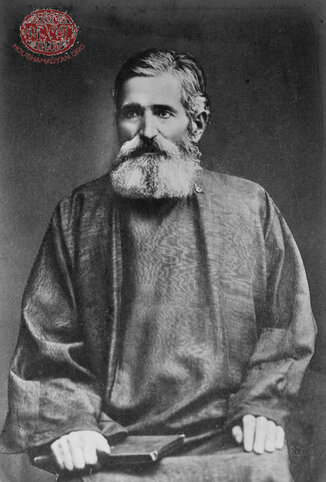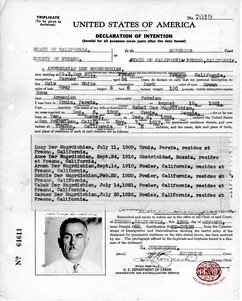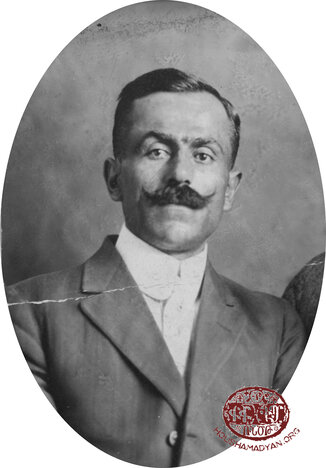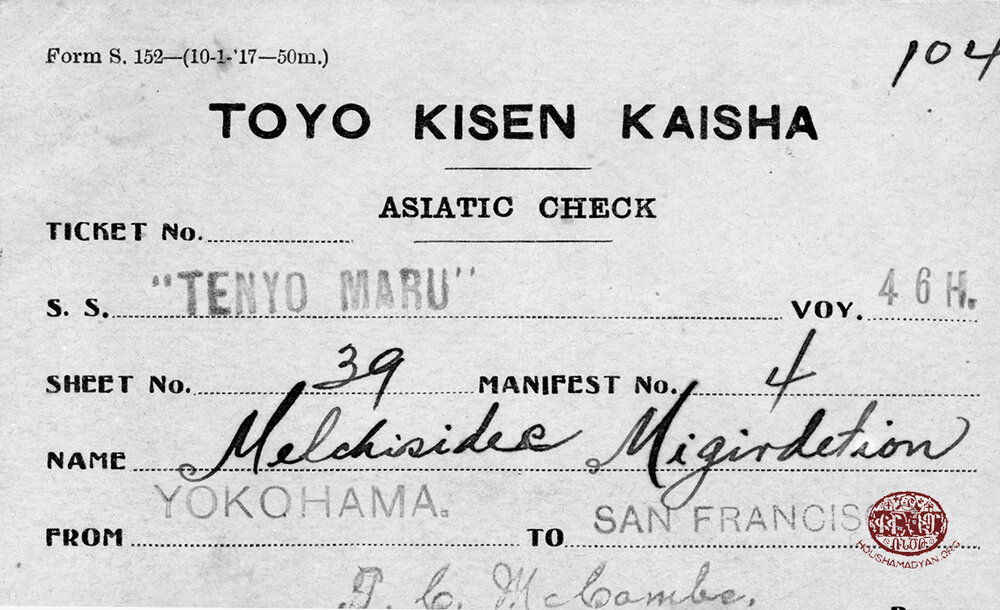Der Mugrdechian Collection - Fresno
Author: Zaroohi Der Mugrdechian, 18/10/2023 (Last modified: 18/10/2023).

The Der Mugrdechian family can trace its lineage to Agha Hovhannes Ardzroonian or Ardzrooni (18th century). A wealthy businessman and merchant from Van, he owned arsenic mines in the Djoulamerg region. He exported the arsenic to Constantinople, where he sold it to local master painters and palace builders. The clan claimed descent from the Artsruni dynasty, which ruled over the region of Van in the Middle Ages.
During the reign of Sultan Selim III (1761-1808), a group of janissaries launched a rebellion in the Van region. To quash this uprising, the Sublime Porte deployed the army to the region. At that time, Agha Hovhannes Ardzroonian was in Constantinople, and it is said that he convinced the authorities to send his friend, Sadik Pasha, to Van, to lead the army detachment tasked with quelling the rebellion. Sadik Pasha arrived in Van in 1801, and Hovhannes Agha became his close advisor. Sadik Pasha succeeded in pacifying the region and took severe measures against the leaders of the rebellion. However, the janissaries of Van had not yet said their last word. They reorganized, and one day, they attacked the mansion of Sadik Pasha with the support of the mob. Sadik Pasha surrendered and was immediately killed by the janissaries. The mob then hunted down Hovhannes Ardzroonian, who was found and ordered to convert to Islam. Hovhannes Agha refused and was killed on the spot. The mob attacked his house, located in the Arark neighborhood, and all members of his family were killed, except for his son, Deovlet Deovletian, Deovlet’s wife, and their young son, the future Father Garabed, the direct ancestor of the Der Mugrdechian clan.

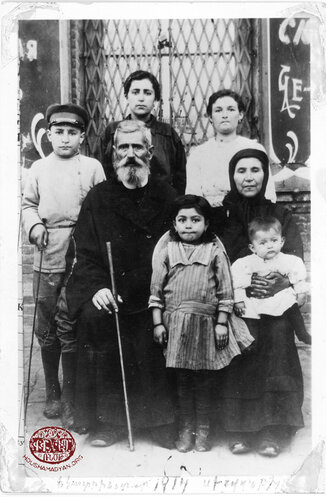
Father Garabed was the parish priest of the Ararouts Holy Virgin Church (Holy Virgin of Arark) or Ayrharouts, located in the south of Aykesdan, in Arark Square. He had a son, who was later ordained Father Mgrdich, and who married Mughsi Mariam. They had five children: Antaram, Srpoohi, Avedis, Garabed and Mardiros.
Mardiros was born in 1843, in the Khanigian neighborhood in Arark, Aykesdan, Van. He married Hripsime Vosbnebassian (or Bassian) in 1877. Hripsime’s father was Hagop Bassian. They had ten children, of whom six survived: Anooshavan, Nevart, Santookht, Anahid, Hranoosh, and Marina.
Mardiros’s family owned a two-story, four-bedroom brick house about six miles from the business district of Van, located on Khach Poghan and Sande Poghan. The family also owned a pasture and a fruit orchard in Ourpat Arou; and more than 20 stores in the Ararouts neighborhood. At the age of 16, Mardiros traveled to the village of Shahbagh to work as a teacher. In 1888, he opened a kindergarten, called the Hripsimian School, in his home. It was the first girls’ school in Van. In 1910, Mardiros was ordained as a priest at Gdoots Monastery, and given the name Melkisetek (or Melkiset). He was the author of many children’s poems and composed music for many songs.


During the 1915 defense of Van, Father Melkisetek took his family to the missionary compound of Van for safety. When the Russian army retreated from the city, the locals had no doubt that the Armenians of the city would all be killed, so the entire family prepared to leave.
Thousands of Van residents fled during the month of August, marching towards the safety of Russian Armenia. Along the way, many died of starvation, exhaustion, and disease. Anahid, the daughter of Father Melkisetek and Hripsime, died during this ordeal.
After arriving in Ashtarak bedraggled and ill, the family stayed in this city until Father Melkisetek’s son, Anooshavan, who had been in America, returned as a volunteer to Armenia. Anooshavan found his family and took them to Tbilisi. Father Melkisetek was offered the position of assistant parish priest in Yekaterinodar (present-day Krasnodar), in Southern Russia. He accepted, and the family lived there for a year and a half.
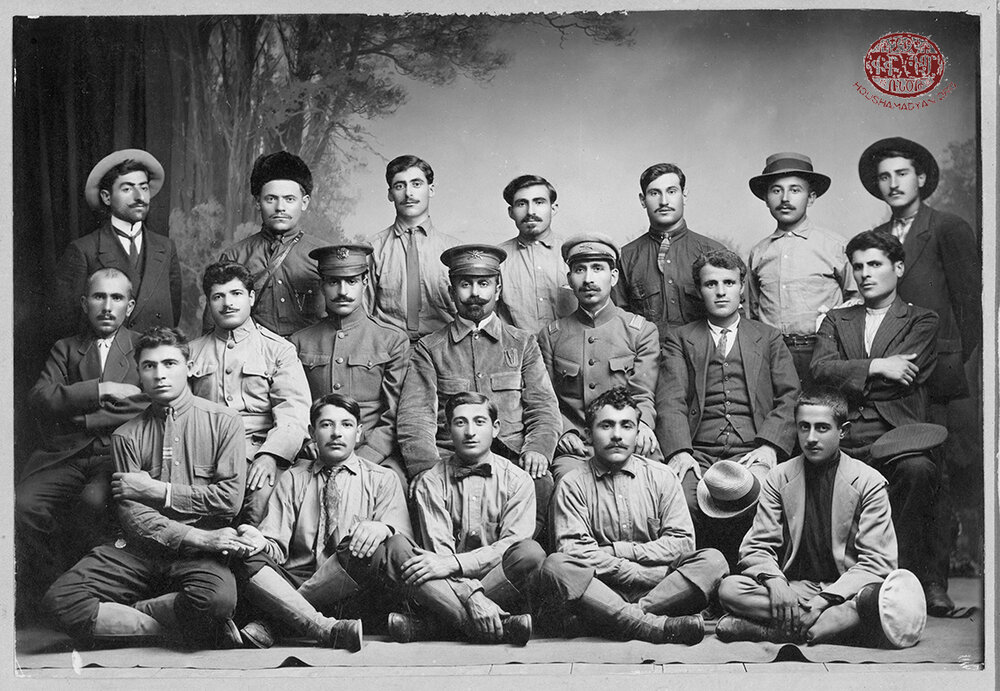
Anooshavan then traveled to America. He traveled through Japan and in Yokohama met Diana Apcar, the Honorary Consul of the Republic of Armenia to Japan, who assisted him by providing him a loan to travel to America. In California, a friend of his arranged an offer for Father Melkisetek to serve as the parish priest of the St. Gregory Armenian Apostolic Church in Fowler, California. Father Melkisetek; his wife, Hripsime; Anooshavan’s wife, Rakel; and their children, Lucy and Anne, traveled to America. The journey took them 6,000 miles across the Trans-Siberian railway to Vladivostok, where they boarded a ship for Yokohama. After a forty-day stopover in Japan, they crossed the Pacific on the Japanese liner Tenyo Maru and arrived in San Franciso. They then took a train to Fowler, California.
Father Melkisetek assumed the pastorage of the St. Gregory Armenian Apostolic Church in March of 1918, and served in that capacity until his death on March 19, 1919. He died of Spanish influenza, during the worldwide pandemic. His family also caught the flu and were ill, so they were not even able to attend his funeral. Hripsime lived with her family until her death in 1947.
Eventually, Father Melkisetek’s daughters, Nevart and Marina, alongside their families, made their way to the United States.


Anooshavan Der Mugrdechian
Anooshavan was born on July 15, 1879. He was the only son and oldest child of Father Melkisetek and Hripsime Der Mugrdechian. He was educated at the St. Tarkmanchats School of Van. On Monday, June 3, 1896, Anooshavan helped save the lives of fellow students when Turkish mobs attacked the city. For six days, Armenians held off Turkish attacks. In the end, all Armenians were instructed to evacuate before the Turks overran the city. Eventually, Armenians returned and began rebuilding their neighborhoods and lives, despite the huge difficulties that they faced.
Anooshavan became an important member of the Armenakan party, the oldest Armenian political party in the Ottoman Empire, established in 1885 in Van. He was arrested and imprisoned several times by the Ottoman authorities. Throughout his revolutionary career, he often came into conflict with the Dashnak Party (Armenian Revolutionary Federation), a rival revolutionary Armenian party. Anooshavan eventually left Van and moved to Urmia (Iran), where he felt safer. There, he met his bride-to-be, Rakel Sahagian. At age 15, she became engaged to Anooshavan. They married when she was 16 years old, on December 6, 1908. Rakel’s father was Hadji Agha Ohannes Sahagian, and her mother was Zaroohi Sahagian (nee Beylerian).
The couple returned to Van, where Anooshavan worked in the lumber industry. However, he was arrested and imprisoned by the Ottoman authorities for a third time on false charges. After his release in the fall of 1911, Anooshavan decided to leave Van for good and emigrate to America, in order to inform the wider world of recent events in Van. In America, he would become a member of the “Sahmanateer Ramgavar” (Constitutional Democratic) Organization, which, in 1921, became the Ramgavar Party (Armenian Democratic-Liberal Party).
After many adventures, he finally reached London, and then Liverpool. He crossed the ocean and reached Chelsea, Massachusetts, where his father- and mother-in-law lived. At the outset of the First World War, Anooshavan became a leading member of the Armenian Volunteer Battalions fighting in the Caucasus. Traveling through Tbilisi, he reached Echmiadzin, where he began looking for his family after hearing that the Armenians of Van had retreated in that direction. He found his parents, sisters, and wife. Rakel was on the verge of death, so he found doctors who nursed her back to life. When the Constitutional Democratic Organization realized that it could not change the course of events in Armenia, Anooshavan was called back to America.
In 1916, Anooshavan traveled on the Trans-Siberian Railroad to return to the United States. He stopped in Fowler, California to visit friends. While there, he was offered a position for his father, Father Melkisetek, to serve as the parish priest of the St. Gregory Church in Fowler. His father accepted the offer, and by 1917, the entire family was reunited in Fowler.
Anooshavan and Rakel already had two daughters (Lucy and Anahid), born before their move to America. After their move, they had another daughter Armen, and three sons, christened Melkisetek (Babig; abbreviated to Bob); Vahak; and Barr. During the 1930s, they lived a simple life, working as farmhands on a number of small ranches.
Anooshavan was a leader in the Armenian Democratic-Liberal Party, the Bowles-Oleander chapter of the Armenian General Benevolent Union (AGBU), the St. Gregory Armenian Apostolic Church of Fowler (where he served as a member of the parish council and in the Armenian school), Vasbouragan Society (in which he was a chairman), and the Armenian Friendship Society. He was a charismatic speaker and very successful at raising funds for numerous projects. His wife, Rakel, was an active member of the St. Gregory Armenian Apostolic Church Ladies’ Society, the AGBU, the Armenian Democratic-Liberal Party, and the Vasbouragan Society. They raised their children to be good Americans who are active in their communities. They had 16 grandchildren.
Anooshavan died on November 1, 1966. Rakel died on April 19, 1997.


